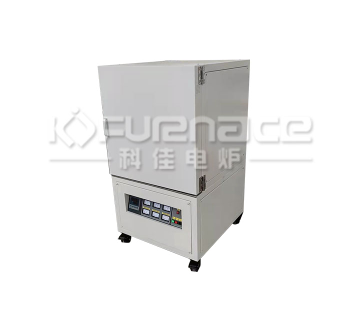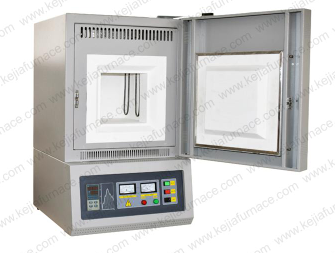1. The core principle of muffle furnace tempering
Muffle furnace tempering converts electrical energy into thermal energy through electric heating elements (such as nickel chromium alloy wire, silicon carbon rod), forming a high-temperature environment (usually 500-650 ℃) in the furnace, and using heat conduction, convection, and radiation to heat metal materials.
Core process:
Heating stage: The resistance wire is electrified to generate heat, and the temperature control system (such as PID controller) maintains the set temperature to ensure temperature uniformity inside the furnace (temperature difference ± 5 ℃).
Insulation stage: The material is kept at the target temperature for a certain period of time to homogenize the internal structure and eliminate quenching stress.
Cooling stage: Cooling in a controllable manner (such as air cooling, water cooling), adjusting the hardness and toughness of the material.

A commonly used tempering muffle furnace with a maximum temperature of 1200 ℃ (click on the image to view product details)
2. Key performance advantages of muffle furnace tempering
Accurate temperature control
Adopting an intelligent temperature control system (such as PID closed-loop control), the temperature fluctuation is small, ensuring the stability of the tempering process. For example, the KJ-M1700-12LZ muffle furnace has a rated temperature of 1700 ℃ and a temperature control accuracy of ± 1 ℃, meeting the requirements of high-temperature and high-precision heat treatment.
Good heating uniformity
Furnace design (such as high-quality alumina polycrystalline fiber material) reduces heat loss, combined with evenly distributed heating elements, to avoid local overheating or underheating of the material and prevent internal stress generation.
Easy to operate and safe
Intelligent interface: equipped with touch screen or digital instrument, intuitive parameter settings, and support for multi-stage program heating.
Safety protection: functions such as over temperature alarm, thermocouple protection, leakage protection, etc. Some models have the function of opening the door and cutting off power to ensure safe operation.
Energy-saving and environmental protection
By using good insulation materials (such as ceramic fibers) and energy-saving design, the furnace body has good sealing performance, reduces heat loss, and lowers energy consumption.
3. Application fields of muffle furnace tempering
metal heat treatment
Tempering process: reduces the hardness and brittleness of the quenched metal, and improves toughness, plasticity, or electrical properties. For example, after tempering at 500-600 ℃, the hardness and impact toughness of high Mo high chromium cast iron are greatly improved.
Annealing process: eliminates internal stress in metals and improves processing performance. After annealing at 850 ℃, the plasticity of spring nuts is enhanced.
Ceramics and Powder Metallurgy
Ceramic sintering: High temperature treatment of ceramic bodies to densify them and improve their mechanical and electrical properties.
Powder metallurgy: used for sintering and forming powder products to prepare high-performance parts.
Laboratory research
Material performance research: for universities and research institutes to conduct experiments on high-temperature properties and chemical reaction mechanisms of materials. For example, studying the microstructural changes of materials at tempering temperature.
Sample pretreatment: Sample preparation before characterization using techniques such as thermogravimetric analysis (TGA) and X-ray diffraction (XRD).

KJ-M1700-12LZ maximum temperature 1700 ℃ high temperature tempering muffle furnace (click on the picture to view product details)
4. Suggestions for selection of muffle furnace tempering
temperature range
According to the process requirements, common models cover temperatures between 500-1800 ℃. For example, KJ-M1200-3.4LZ type has a rated temperature of 1200 ℃ and is suitable for general tempering; Models above 1200 ℃ can be used for high-temperature annealing.
Furnace size and material
Size: Choose according to the material processing capacity. Common furnace sizes include 150 × 150 × 150mm, 300 × 300 × 300mm, etc.
Material: Aluminum oxide polycrystalline fiber material has high temperature resistance and good insulation, suitable for long-term high-temperature use.
Temperature control system
Priority should be given to intelligent temperature control instruments that support multi-stage program heating, with temperature control accuracy within ± 1 ℃ to ensure process repeatability.
Security and Additional Features
Security protection: functions such as over temperature alarm, break protection, and leakage protection are essential.
Additional functions: Atmosphere control (such as Ar gas protection), data recording and analysis can improve experimental efficiency.Click to learn more Muffle Furnaces! Or click on online customer service to learn more about product information!